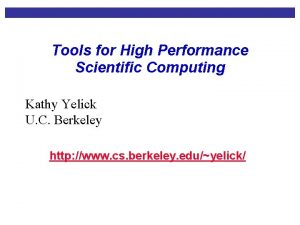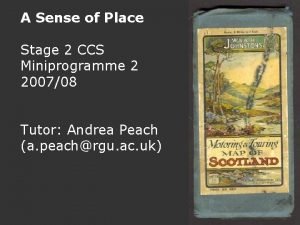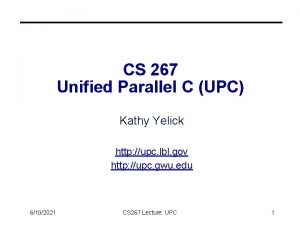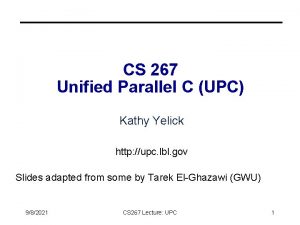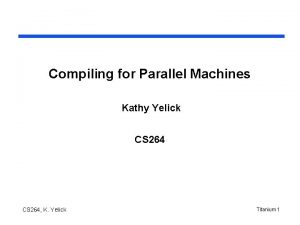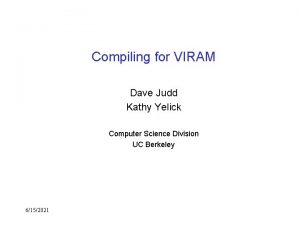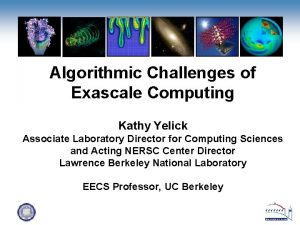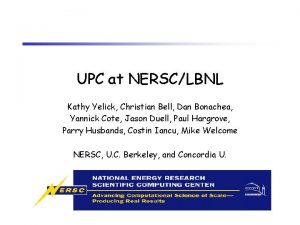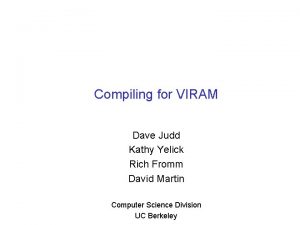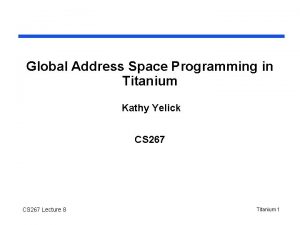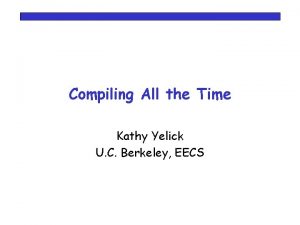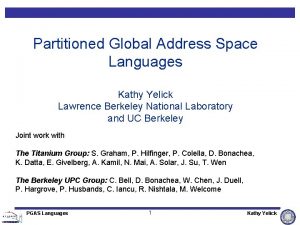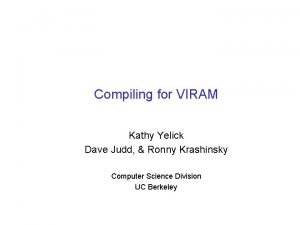Unified Parallel C Kathy Yelick EECS U C




















![UPC Matrix Multiplication Code /* mat_mult_1. c */ #include <upc_relaxed. h> shared [N*P /THREADS] UPC Matrix Multiplication Code /* mat_mult_1. c */ #include <upc_relaxed. h> shared [N*P /THREADS]](https://slidetodoc.com/presentation_image_h2/46e5bc0b9ba39ac8d2e1e4e969a67dcb/image-21.jpg)





















- Slides: 42

Unified Parallel C Kathy Yelick EECS, U. C. Berkeley and NERSC/LBNL NERSC Team: Dan Bonachea, Jason Duell, Paul Hargrove, Parry Husbands, Costin Iancu, Mike Welcome, Christian Bell Some slides from: Tarek El Ghazawi and Bill Carlson

Outline • Motivation for a new class of languages – Programming models – Architectural trends • Overview of Unified Parallel C (UPC) – Programmability advantage – Performance opportunity • Status – Next step • Related projects

Programming Model 1: Shared Memory • Program is a collection of threads of control. – Many languages allow threads to be created dynamically, • Each thread has a set of private variables, e. g. local variables on the stack. • Collectively with a set of shared variables, e. g. , static variables, shared common blocks, global heap. – Threads communicate implicitly by writing/reading shared variables. – Threads coordinate using synchronization operations on shared variables Shared y =. . x. . . x =. . . Private P 0 P 1 . . . Pn

Programming Model 2: Message Passing • Program consists of a collection of named processes. – Usually fixed at program startup time – Thread of control plus local address space -- NO shared data. – Logically shared data is partitioned over local processes. • Processes communicate by explicit send/receive pairs – Coordination is implicit in every communication event. – MPI is the most common example send P 0, X recv Pn, Y Y P 0 X P 1 . . . Pn

Advantages/Disadvantages of Each Model • Shared memory 1. Programming is easier • Can build large shared data structures – Machines don’t scale • SMPs typically < 16 processors (Sun, DEC, Intel, IBM) • Distributed shared memory < 128 (SGI) – Performance is hard to predict and control • Message passing + Machines easier to build from commodity parts – Can scale (given sufficient network) – Programming is harder • Distributed data structures only in the programmers mind • Tedious packing/unpacking of irregular data structures

Global Address Space Programming • Intermediate point between message passing and shared memory • Program consists of a collection of processes. – Fixed at program startup time, like MPI • Local and shared data, as in shared memory model – But, shared data is partitioned over local processes – Remote data stays remote on distributed memory machines – Processes communicate by reads/writes to shared variables • Examples are UPC, Titanium, CAF, Split-C • Note: These are not data-parallel languages – heroic compilers not required

GAS Languages on Clusters of SMPs • SMPs are the fastest commodity machine, so used as a node in large-scale clusters • Common names: – CLUMP = Cluster of SMPs – Hierarchical machines, constellations • Most modern machines look like this: – Millennium, IBM SPs, (not the t 3 e). . . • What is an appropriate programming model? – Use message passing throughout • Unnecessary packing/unpacking overhead – Hybrid models • Write 2 parallel programs (MPI + Open. MP or Threads) – Global address space • Only adds test (on/off node) before local read/write

Top 500 Supercomputers • Listing of the 500 most powerful computers in the world - Yardstick: Rmax from LINPACK MPP benchmark Ax=b, dense problem Rate performance Size - Dense LU Factorization (dominated by matrix multiply) • Updated twice a year SC‘xy in the States in November – Meeting in Mannheim, Germany in June – All data (and slides) available from www. top 500. org – Also measures N-1/2 (size required to get ½ speed)



Outline • Motivation for a new class of languages – Programming models – Architectural trends • Overview of Unified Parallel C (UPC) – Programmability advantage – Performance opportunity • Status – Next step • Related projects

Parallelism Model in UPC • UPC uses an SPMD model of parallelism – A set if THREADS threads working independently • Two compilation models – THREADS may be fixed at compile time or – Dynamically set at program startup time • MYTHREAD specifies thread index (0. . THREADS-1) • Basic synchronization mechanisms – Barriers (normal and split-phase), locks • What UPC does not do automatically: – Determine data layout – Load balance – move computations – Caching – move data • These are intentionally left to the programmer

Shared and Private Variables in UPC • A shared variable has one instance, shared by all threads. – Affinity to thread 0 by default (allocated in processor 0’s memory) • A private variable has an instance per thread • Example: int x; // private copy for each processor shared int y; // one copy on P 0, shared by all others x = 0; y = 0; x += 1; y += 1; • After executing this code – x will be 1 in all threads; y will be between 1 and THREADS • Shared scalar variable are somewhat rare because: – cannot be automatic (declared in a function) (Why not? )

UPC Pointers Global address space • Pointers may point to shared or private variables • Same syntax for use, just add qualifier shared int *sp; int *lp; • sp is a pointer to an integer residing in the shared memory space. • sp is called a shared pointer (somewhat sloppy). x: 3 sp: lp: Shared sp: lp: Private

Shared Arrays in UPV • Shared array elements are spread across the threads shared int x[THREADS] /*One element per thread */ shared int y[3][THREADS] /* 3 elements per thread */ shared int z[3*THREADS] /* 3 elements per thread, cyclic */ • In the pictures below – Assume THREADS = 4 – Elements with affinity to processor 0 are red x y blocked z cyclic Of course, this is really a 2 D array

Work Sharing with upc_forall() • Iterations are independent • Each thread gets a bunch of iterations • Simple C-like syntax and semantics upc_forall(init; test; loop; affinity) statement; • Affinity field to distribute the work – Round robin – Chunks of iterations • Semantics are undefined if there are dependencies between iterations – Programmer has indicated iterations are independent

Vector Addition with upc_forall • The loop in vadd is common, so there is upc_forall: • 4 th argument is int expression that gives “affinity” • Iteration executes when: • affinity%THREADS is MYTHREAD /* vadd. c */ #include <upc_relaxed. h> #define N 100*THREADS shared int v 1[N], v 2[N], sum[N]; void main() { int i; upc_forall(i=0; i<N; i++; i) sum[i]=v 1[i]+v 2[i]; }

Layouts in General • All non-array objects have affinity with thread zero. • Array layouts are controlled by layout specifiers. layout_specifier: : null layout_specifier [ integer_expression ] • The affinity of an array element is defined in terms of the • block size, a compile-time constant, and THREADS a runtime constant. • Element i has affinity with thread ( i / block_size) % PROCS.

2 D Array Layouts in UPC • Array a 1 has a row layout and array a 2 has a block row layout. shared [m] int a 1 [n][m]; shared [k*m] int a 2 [n][m]; • If (k + m) % THREADS = = 0 them a 3 has a row layout shared int a 3 [n][m+k]; • To get more general HPF and Sca. LAPACK style 2 D blocked layouts, one needs to add dimensions. • Assume r*c = THREADS; shared [b 1][b 2] int a 5 [m][n][r][c][b 1][b 2]; • or equivalently shared [b 1*b 2] int a 5 [m][n][r][c][b 1][b 2];

Domain Decomposition for UPC • Exploits locality in matrix multiplication • A (N P) is decomposed row-wise into blocks of size (N P) / THREADS as shown below: • B(P M) is decomposed column wise into M/ THREADS blocks as shown below: Thread 0 P 0. . (N*P / THREADS) -1 (N*P / THREADS). . (2*N*P / THREADS)-1 Thread THREADS-1 M Thread 0 Thread 1 N P ((THREADS-1) N*P) / THREADS. . (THREADS*N*P / THREADS)-1 Thread THREADS-1 • Note: N and M are assumed to be multiples of THREADS Columns 0: (M/THREADS)-1 Columns ((THREAD-1) M)/THREADS: (M-1)
![UPC Matrix Multiplication Code matmult1 c include upcrelaxed h shared NP THREADS UPC Matrix Multiplication Code /* mat_mult_1. c */ #include <upc_relaxed. h> shared [N*P /THREADS]](https://slidetodoc.com/presentation_image_h2/46e5bc0b9ba39ac8d2e1e4e969a67dcb/image-21.jpg)
UPC Matrix Multiplication Code /* mat_mult_1. c */ #include <upc_relaxed. h> shared [N*P /THREADS] int a[N][P], c[N][M]; // a and c are row-wise blocked shared matrices shared[M/THREADS] int b[P][M]; //column-wise blocking void main (void) { int i, j , l; // private variables upc_forall(i = 0 ; i<N ; i++; &c[i][0]) { for (j=0 ; j<M ; j++) { c[i][j] = 0; for (l= 0 ; l P ; l++) c[i][j] += a[i][l]*b[l][j]; } } }

Notes on the Matrix Multiplication Example • The UPC code for the matrix multiplication is almost the same size as the sequential code • Shared variable declarations include the keyword shared • Making a private copy of matrix B in each thread might result in better performance since many remote memory operations can be avoided • Can be done with the help of upc_memget

Overlapping Communication in UPC • Programs with fine-grained communication require overlap for performance • UPC compiler does this automatically for “relaxed” accesses. – Acesses may be designated as strict, relaxed, or unqualified (the default). – There are several ways of designating the ordering type. • A type qualifier, strict or relaxed can be used to affect all variables of that type. • Labels strict or relaxed can be used to control the accesses within a statement. strict : { x = y ; z = y+1; } • A strict or relaxed cast can be used to override the current label or type qualifier.

Performance of UPC • Reason why UPC may be slower than MPI – Shared array indexing is expensive – Small messages encouraged by model • Reasons why UPC may be faster than MPI – MPI encourages synchrony – Buffering required for many MPI calls • Remote read/write of a single word may require very little overhead • Cray t 3 e, Quadrics interconnect (next version) • Assuming overlapped communication, the real issues is overhead: how much time does it take to issue a remote read/write?

UPC versus MPI for Edge detection a. Execution time b. Scalability • Performance from Cray T 3 E • Benchmark developed by El Ghazawi’s group at GWU

UPC versus MPI for Matrix Multiplication a. Execution time b. Scalability • Performance from Cray T 3 E • Benchmark developed by El Ghazawi’s group at GWU

UPC vs. MPI for Sparse Matrix-Vector Multiply • Short term goal: – Evaluate language and compilers using small applications • Show advantage of t 3 e network model and UPC • Performance on Compaq machine worse: - Serial code - Communication performance - New compiler just released • Longer term, identify large application

Particle/Grid Methods in UPC ? • Experience so far in a related language – Titanium, Java-based GAS language – Immersed boundary method • Most time in communication between mesh and particles • Currently uses bulk communication • May benefit from SPMV trick

EM 3 D Performance in Split-C Language on CM-5 Maxwells Equations on an Unstructured 3 D Mesh: Explicit Method Irregular Bipartite Graph of varying degree (about 20) with weighted edges v 1 v 2 w 1 w 2 H E B D Basic operation is to subtract weighted sum of neighboring values for all E nodes for all H nodes

Split-C: Performance Tuning on the CM 5 • Tuning affects application performance

Outline • Motivation for a new class of languages – Programming models – Architectural trends • Overview of Unified Parallel C (UPC) – Programmability advantage – Performance opportunity • Status – Next step • Related projects

UPC Implementation Effort • UPC efforts elsewhere – – – IDA: t 3 e implementation based on old gcc GMU (documentation) and UMC (benchmarking) Compaq (Alpha cluster and C+MPI compiler (with MTU)) Cray, Sun, and HP (implementations) Intrepid (SGI compiler and t 3 e compiler) • UPC Book: – T. El-Ghazawi, B. Carlson, T. Sterling, K. Yelick • Three components of NERSC effort 1) Compilers (SP and PC clusters) + optimization (DOE) 2) Runtime systems for multiple compilers (DOE + NSA) 3) Applications and benchmarks (DOE)

Compiler Status • NERSC compiler (Costin Iancu) – Based on Open 64 compiler for C – Parses and type-checks UPC – Code generation for SMPs underway • Generate C on most machines, possibly IA 64 later – Investigating optimization opportunities • Focus of this compiler is high level optimizations • Intrepid compiler – Based on gcc (3. x) – Will target our runtime layer on most machines – Initial focus is t 3 e, then Pentium clusters

Runtime System • Characterizing network performance – Low latency (low overhead) -> programmability • Optimization depend on network characteristics – T 3 e was ideal – Quadrics reports very low overhead coming – Difficult to access low level SP and Myrinet

Next Step • Undertake larger application effort • What type of application? – Challenging to write in MPI (e. g. , sparse direct solvers) – Irregular communication (e. g. , PIC) – Well-understood algorithm

Outline • Motivation for a new class of languages – Programming models – Architectural trends • Overview of Unified Parallel C (UPC) – Programmability advantage – Performance opportunity • Status – Next step • Related projects

3 Related Projects on Campus • Titanium – High performance Java dialect – Collaboration with Phil Colella and Charlie Peskin • Be. BOP: Berkeley Benchmarking and Optimization – Self-tuning numerical kernels – Sparse matrix operations • Pyramid mesh generator (Jonathan Shewchuk)

Locality and Parallelism Conventional Storage Proc Hierarchy Cache L 2 Cache Proc Cache L 2 Cache L 3 Cache Memory • Large memories are slow, fast memories are small. • Storage hierarchies are large and fast on average. • Parallel processors, collectively, have large, fast memories -- the slow accesses to “remote” data we call “communication”. • Algorithm should do most work on local data. potential interconnects L 3 Cache

Tuning pays off – ATLAS (Dongarra, Whaley) Extends applicability of PHIPAC Incorporated in Matlab (with rest of LAPACK)

Speedups on SPMV from Sparsity on Sun Ultra 1/170 – 1 RHS

Speedups on SPMV from Sparsity on Sun Ultra 1/170 – 9 RHS

Future Work • Exploit Itanium Architecture – 128 (82 -bit) floating point registers – – – • 9 HW formats: 24/8(v), 24/15, 24/17, 53/11, 53/15, 53/17, 64/15, 64/17 • Many few load/store instructions fused multiply-add instruction predicated instructions rotating registers for software pipelining prefetch instructions three levels of cache • Tune current and wider set of kernels – Improve heuristics, eg choice of r x c • Incorporate into – SUGAR – Information Retrieval
 Kathy yelick
Kathy yelick Kathy yelick
Kathy yelick Christian yelick
Christian yelick Shmemga
Shmemga Unified parallel c
Unified parallel c Costin iancu
Costin iancu Annie's dress was old, faded, and it had wrinkles.
Annie's dress was old, faded, and it had wrinkles. Parallelosm
Parallelosm Parallelism sentence
Parallelism sentence 5 examples of like parallel forces
5 examples of like parallel forces Mary likes hiking swimming and to ride a bicycle
Mary likes hiking swimming and to ride a bicycle The outer terminus in the pattern area
The outer terminus in the pattern area Piso shift register circuit diagram
Piso shift register circuit diagram Kathy karich
Kathy karich Kathy heistand
Kathy heistand Kathy charmaz constructivist grounded theory
Kathy charmaz constructivist grounded theory Kathy prendergast lost
Kathy prendergast lost Kathy kubo
Kathy kubo Kathy lauer
Kathy lauer Fig 2
Fig 2 Geovette washington
Geovette washington Kathy moser
Kathy moser Psychological first aid help card
Psychological first aid help card Kathy dumbleton
Kathy dumbleton Modern project management began with what project
Modern project management began with what project Kathy fontaine
Kathy fontaine Kathy gamboa
Kathy gamboa Kathy cooksey
Kathy cooksey Kathy fontaine
Kathy fontaine Kathy lemon sjsu
Kathy lemon sjsu Healthcare project management kathy schwalbe
Healthcare project management kathy schwalbe Kathy booth wested
Kathy booth wested Kathy plans to purchase a car that depreciates
Kathy plans to purchase a car that depreciates Kathy shum
Kathy shum Oleaceae characteristics
Oleaceae characteristics Mood gym club
Mood gym club Lingo model example
Lingo model example Kathy wallis
Kathy wallis Dr kathy weston
Dr kathy weston Kathy alfano
Kathy alfano Kathy wonderly
Kathy wonderly Kathy zilch
Kathy zilch Seopr
Seopr

